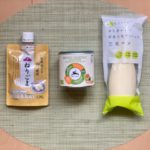Vegan Kitchen Staples in Japan (Pt 2)
Jackie shared her vegan kitchen staples last week, so this week is my turn to share some of the items I always have stocked as a vegan in Japan.
Her list included some great staples that honestly overlap with some of my own (tahini is life). However, given that we have different cooking styles, I thought I would share my own to give you guys even more ideas on how to get started with vegan cooking in Japan.
Must-Have Kitchen Staples for Vegan Life in Japan
Gochujang

If you love spicy food, then gochujang is essential.
Gochujang is a Korean fermented hot pepper paste that goes well with pretty much anything. The main ingredients are chili powder, glutinous rice, fermented soy beans, sugar, and salt.
I use it for spicy soups, sauces, and marinade. It is basically like a spicy miso, so you can replace miso paste with gochujang in any of your recipes.

Rice noodles with gochujang sauce
For stir fries, air-fried tofu, or fried rice, a go-to sauce I make is:
- 1 tsp sesame oil
- 1 tbsp gochujang
- 1 tsp vinegar (any type) or lemon
- 1 tsp sugar
- Pinch of salt
Gochujang is very popular in Japan and can be found at most grocery stores, Korean or not. It is usually in the Chinese/Asian food section.
Extra firm tofu

Tofu from Shigezo. Courtesy of Tressa Yokohama https://www.tressa-yokohama.jp/shop/popup.jsp?id=3340105&shopid=21195&inc=0
Personally, I much prefer cooking with firm tofu rather than soft.
It doesn’t break apart so easily, and I like the texture more as well.
It is surprisingly hard to find firm tofu in Japan—most of the ones you see in grocery stores are very soft and weak.
You can buy firm tofu from my favorite tofu shop in the city, Shigezo (pictured above). Besides tofu, it sells soy cheese, soy cream cheese, yuba, and sweets like warabi mochi and dango. You can also find dry soy meat, noodles, dried fruit, nuts, and more. I go there every week as part of my grocery shopping routine!
There are over 30 locations in Tokyo, plus more in the surrounding prefectures. You can see the full shop list here.
You can also sometimes find firm tofu at regular grocery stores. Try looking out for the Japanese words for it– it could be written as 堅豆腐 (kata tofu), かた豆腐 (kata tofu), or 木綿豆腐 (momen tofu).

Sushi with tofu
I love putting this type of tofu in stir fries, soups, salads, noodle dishes, salads, sushi… the list goes on.
You can also use the above gochujang sauce as a marinade for your tofu – let it soak in the marinade for 10-20 minutes, then air fry or pan fry until golden.
Sesame Oil

Sesame oil is so fragrant and delicious, it is by far my favorite type of oil. With its distinct nutty and toasty flavor, it amps up the flavor of any meal.
I don’t use it much as a cooking oil—I mainly use it as a sauce ingredient (see sauce recipe above). I especially use it in Asian dishes like fried noodles or fried rice, and sometimes in salad dressing.

Fried rice with sesame oil sauce
I also love to mix a bit of soy sauce, sesame oil, and vinegar as a dipping sauce for sushi or Korean pancakes.
You can find this at any grocery store in Japan, in the same aisle as other oils like canola, olive, etc.
Dried Wakame

Dried wakame is one of the most convenient things to have on hand for when you are short on vegetables.
I just toss some in hot water and bam! We have health.
In addition, it lasts forever, cooks in seconds, and is very healthy.
Just 1 serving of wakame (10 grams or 2 tablespoons) contains a good amount of vitamins and minerals such as iodine, manganese, Vimin A, C, E, and K, folate, and calcium.

An otherwise unhealthy bowl of instant noodles (shin ramen) with wakame for some health
I usually just add it to soups, as it just rehydrates in the pot and it’s easiest this way.
But if you want to add it into cold dishes, just take a handful, put it in a heat-safe bowl, boil some water, and pour the boiling water over the wakame. It will rehydrate in just a few seconds. Then drain, and add it to your dish.
Dried wakame is very easy to find. Most Japanese grocery stores have a section dedicated to seaweed, kombu, and soup stock, and you can find it there.






Pingback: My Favorite Vegan Japanese Dinners to Make – Foodie Adventure Japan
November 23, 2020 at 10:14 am